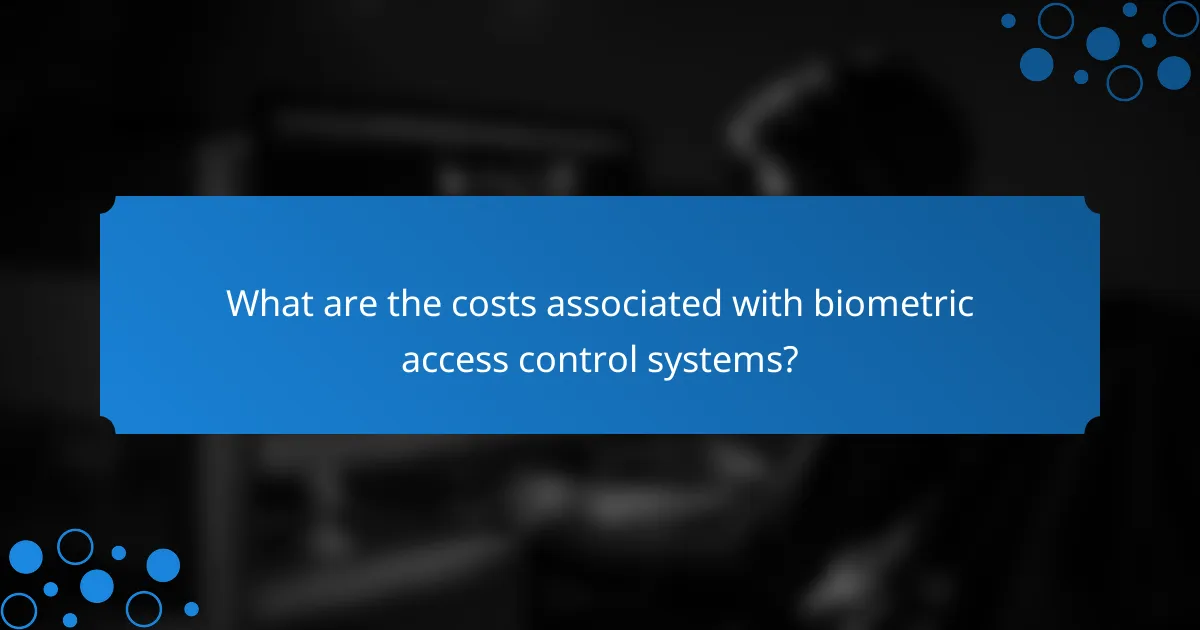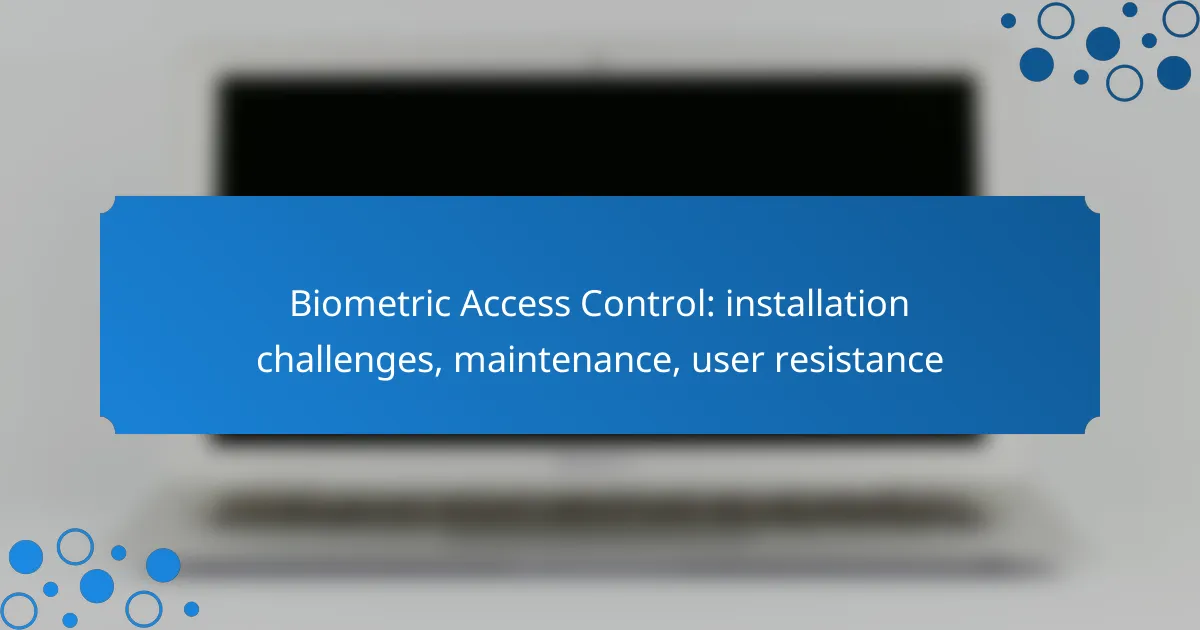Biometric access control systems offer enhanced security but come with installation challenges such as integration with existing infrastructure, environmental considerations, and compliance with regulations. User resistance can hinder adoption, but effective education and involvement in the implementation process can foster acceptance. Additionally, maintaining these systems through regular updates and inspections is essential for ensuring their reliability and performance over time.

What are the installation challenges of biometric access control in Canada?
Installing biometric access control systems in Canada presents several challenges, including integration with existing systems, environmental factors, hardware compatibility, site-specific infrastructure limitations, and regulatory compliance. Addressing these issues is crucial for ensuring effective and reliable biometric security solutions.
Integration with existing systems
Integrating biometric access control with current security systems can be complex. Many organizations use legacy systems that may not support modern biometric technologies, requiring additional software or hardware solutions. It’s essential to assess compatibility early in the planning phase to avoid costly retrofits.
Consider conducting a thorough audit of existing systems to identify potential integration points. This can help streamline the installation process and ensure that all components work seamlessly together.
Environmental factors affecting performance
Environmental conditions can significantly impact the performance of biometric systems. Factors such as temperature, humidity, and lighting can affect the accuracy of fingerprint scanners or facial recognition systems. For instance, extreme cold can cause skin to become less responsive, while bright lights may hinder facial recognition.
To mitigate these issues, select biometric devices designed for specific environmental conditions. Additionally, consider installing protective enclosures or climate control measures to maintain optimal performance.
Hardware compatibility issues
Hardware compatibility is a critical concern when installing biometric access control systems. Different biometric devices may require specific hardware configurations or interfaces, which can lead to challenges if not properly addressed. Ensuring that all components are compatible can prevent delays and additional costs.
Before installation, verify that the chosen biometric hardware is compatible with existing infrastructure. Consulting with vendors or conducting a compatibility assessment can help identify potential issues early on.
Site-specific infrastructure limitations
Site-specific infrastructure limitations can pose significant challenges during installation. Factors such as building layout, available power sources, and network connectivity can affect the deployment of biometric systems. For example, remote locations may lack adequate network coverage, complicating the installation of cloud-based solutions.
Conduct a site survey to evaluate infrastructure capabilities and identify any necessary upgrades. Planning for these limitations can help ensure a smoother installation process and better system performance.
Regulatory compliance requirements
In Canada, biometric access control systems must comply with various privacy and security regulations, such as the Personal Information Protection and Electronic Documents Act (PIPEDA). Organizations must ensure that they handle biometric data responsibly and securely to avoid legal repercussions.
Familiarize yourself with relevant regulations and consult legal experts if necessary. Implementing best practices for data protection and user consent can help organizations navigate compliance challenges effectively.

How can user resistance to biometric access control be addressed?
User resistance to biometric access control can be effectively addressed through targeted education, demonstrating the security benefits, and involving users in the implementation process. By focusing on these strategies, organizations can foster acceptance and ease the transition to biometric systems.
Education and training programs
Implementing comprehensive education and training programs is essential for reducing user resistance. These programs should inform users about how biometric systems work, their benefits, and how to use them effectively. Regular training sessions can help users feel more comfortable and confident in utilizing the technology.
Consider offering workshops or online tutorials that cover common concerns, such as privacy and data security. Providing clear, accessible information can demystify the technology and encourage acceptance among users.
Demonstrating security benefits
Highlighting the security benefits of biometric access control can significantly reduce user skepticism. By showcasing how biometric systems enhance security compared to traditional methods, organizations can build trust. For example, biometric systems can reduce unauthorized access and improve overall safety.
Sharing case studies or statistics that illustrate successful implementations can further reinforce these benefits. Users are more likely to embrace the technology when they understand its effectiveness in protecting sensitive information and assets.
Involving users in the implementation process
Involving users in the implementation process can lead to greater acceptance of biometric access control. Engaging users early on allows them to voice concerns and contribute to the decision-making process. This collaborative approach fosters a sense of ownership and reduces resistance.
Consider forming a user advisory group to gather feedback and suggestions during the rollout. This not only helps tailor the system to user needs but also demonstrates that their opinions are valued, making them more likely to support the new technology.

What maintenance practices are essential for biometric systems?
Essential maintenance practices for biometric systems include regular software updates, hardware inspections and cleaning, and user data management protocols. These practices ensure optimal performance, security, and user satisfaction over time.
Regular software updates
Regular software updates are crucial for maintaining the security and functionality of biometric systems. These updates often include security patches, new features, and performance enhancements that help protect against vulnerabilities.
To ensure timely updates, establish a schedule that aligns with the vendor’s release cycle. Consider automating the update process where possible to minimize downtime and user disruption.
Hardware inspections and cleaning
Routine hardware inspections and cleaning are vital for the longevity of biometric devices. Dust, dirt, and wear can affect the accuracy of biometric readings, leading to user frustration and system inefficiencies.
Inspect devices at least quarterly, checking for physical damage and ensuring that sensors are clean. Use manufacturer-recommended cleaning solutions and techniques to avoid damaging sensitive components.
User data management protocols
Effective user data management protocols are essential for ensuring the integrity and security of biometric information. This includes establishing guidelines for data collection, storage, access, and deletion to comply with privacy regulations.
Implement strong access controls and regularly audit user permissions to prevent unauthorized access. Additionally, educate users on the importance of data security to foster trust and compliance with the system.

What are the costs associated with biometric access control systems?
The costs associated with biometric access control systems include initial installation expenses, ongoing maintenance costs, and investments in training and support. Understanding these costs helps organizations budget effectively and ensure smooth implementation.
Initial installation expenses
Initial installation expenses for biometric access control systems can vary widely depending on the technology chosen, such as fingerprint scanners, facial recognition systems, or iris scanners. Costs typically range from several hundred to several thousand USD per unit, plus installation fees that may add another 20-30% to the total expense.
Factors influencing installation costs include the number of access points, the complexity of the integration with existing systems, and any necessary infrastructure upgrades. Organizations should plan for potential additional costs related to site preparation and hardware compatibility.
Ongoing maintenance costs
Ongoing maintenance costs are essential to consider for biometric access control systems. These costs can include software updates, hardware repairs, and regular system checks, which may total around 10-15% of the initial installation cost annually.
Organizations should also account for potential replacement of biometric readers or sensors, which may wear out over time. A proactive maintenance plan can help mitigate unexpected expenses and ensure system reliability.
Training and support investments
Investing in training and support is crucial for the successful implementation of biometric access control systems. Training costs can vary, but budgeting for a few hundred to a few thousand USD for staff training sessions is advisable, depending on the number of users and the complexity of the system.
Additionally, ongoing support from vendors or third-party service providers may incur monthly or annual fees. Organizations should evaluate their support needs and consider options for both in-house and external training resources to maximize user adoption and system effectiveness.

What are the key factors to consider when selecting a biometric access control solution?
When selecting a biometric access control solution, consider factors such as scalability, vendor reputation, and technology compatibility. These elements will significantly influence the effectiveness and longevity of the system in meeting your security needs.
Scalability of the system
Scalability refers to the system’s ability to grow and adapt as your organization expands. A scalable biometric access control solution should accommodate an increasing number of users and devices without compromising performance.
When evaluating scalability, look for systems that allow for easy integration of additional biometric readers and software updates. This flexibility can save costs and reduce the need for a complete system overhaul in the future.
Vendor reputation and support
The reputation of the vendor is crucial in ensuring reliable performance and support for your biometric access control system. Research the vendor’s history, customer reviews, and case studies to assess their reliability and service quality.
Additionally, consider the level of customer support offered. A vendor that provides comprehensive training, timely updates, and responsive technical assistance can significantly enhance your experience and minimize downtime.
Technology compatibility
Technology compatibility ensures that the biometric access control system can seamlessly integrate with your existing infrastructure. Check if the solution supports various biometric modalities, such as fingerprint, facial recognition, or iris scanning, and if it can work with your current security systems.
Moreover, ensure that the system complies with industry standards and regulations relevant to your location, such as GDPR in Europe or CCPA in California. This compliance not only enhances security but also protects your organization from potential legal issues.
